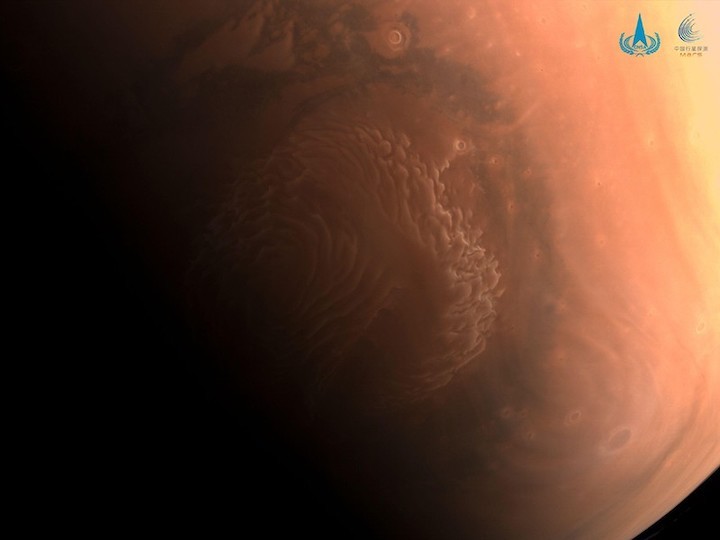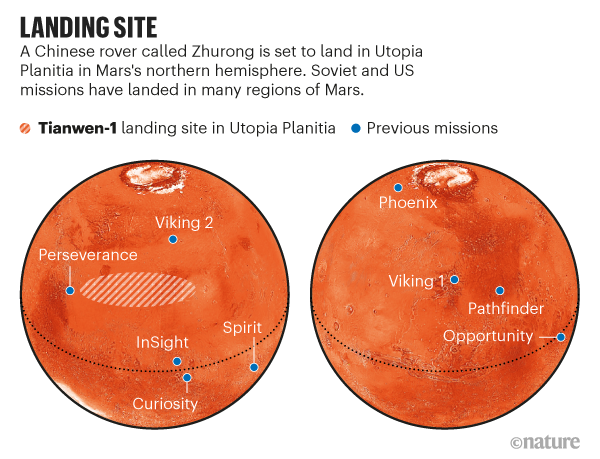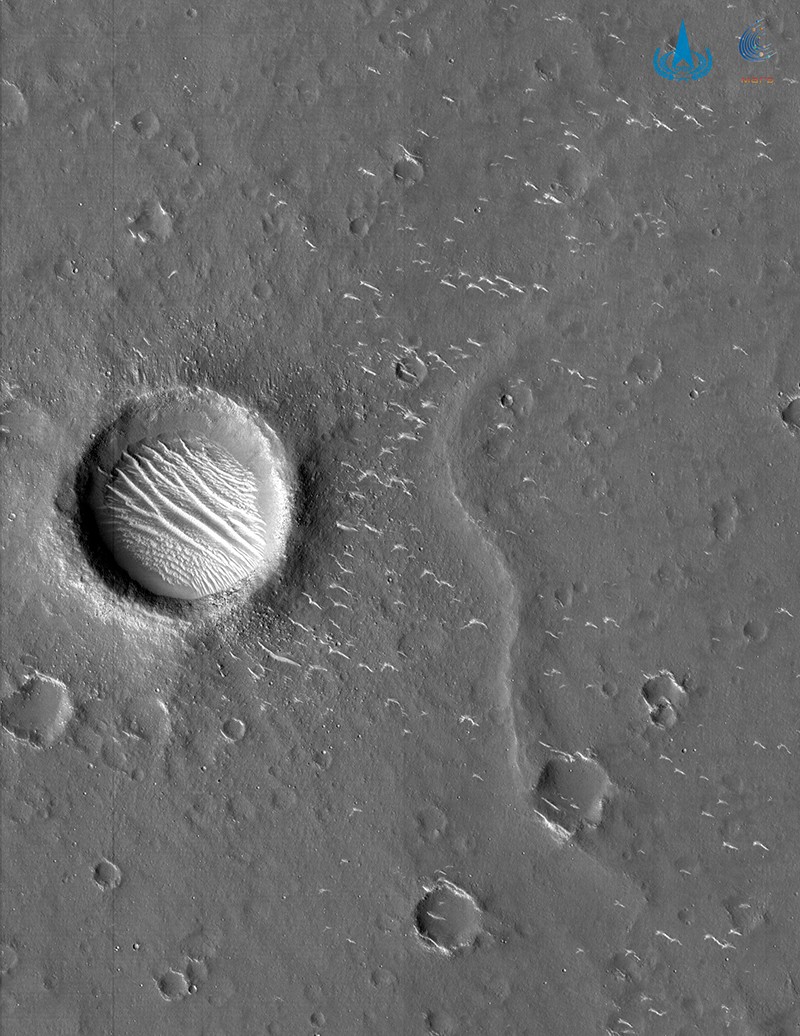28.03.2021
China releases new images of Mars from Tianwen-1 probe
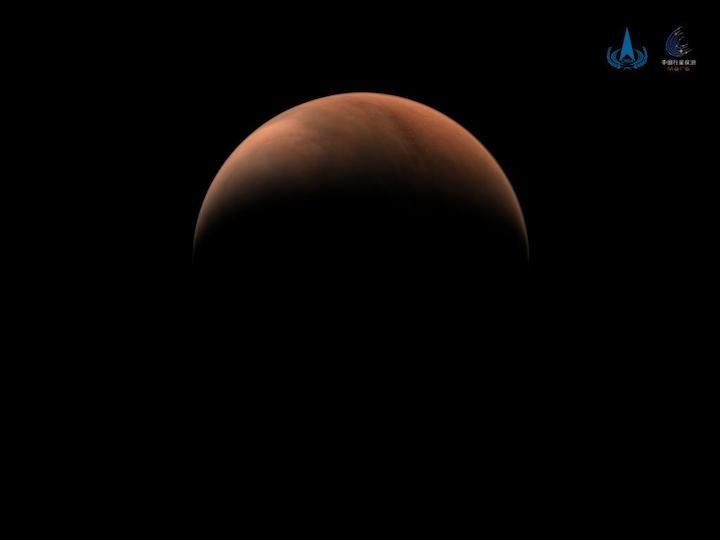
Photo taken on March 18, 2021 shows an image of Mars captured by China's Tianwen-1 probe. The China National Space Administration (CNSA) on Friday released two new images of Mars captured by the country's Tianwen-1 probe. In the images, Mars is crescent-shaped with a clear surface texture. When the Tianwen-1 probe was 11,000 km away from Mars on the far side of the planet to the sun, it took panoramic photos of Mars with a medium-resolution camera onboard. (CNSA/Handout via Xinhua)
The China National Space Administration (CNSA) on Friday released two new images of Mars captured by the country's Tianwen-1 probe.
In the images, Mars is crescent-shaped with a clear surface texture.
When the Tianwen-1 probe was 11,000 km away from Mars on the far side of the planet to the sun, it took panoramic photos of Mars with a medium-resolution camera onboard.
The Tianwen-1 probe has been operating in the parking orbit around Mars for a month. The high-resolution camera, medium-resolution camera, mineral spectrometer and other payloads onboard were switched on successively to carry out exploration of Mars and obtain scientific data, according to the CNSA. Enditem
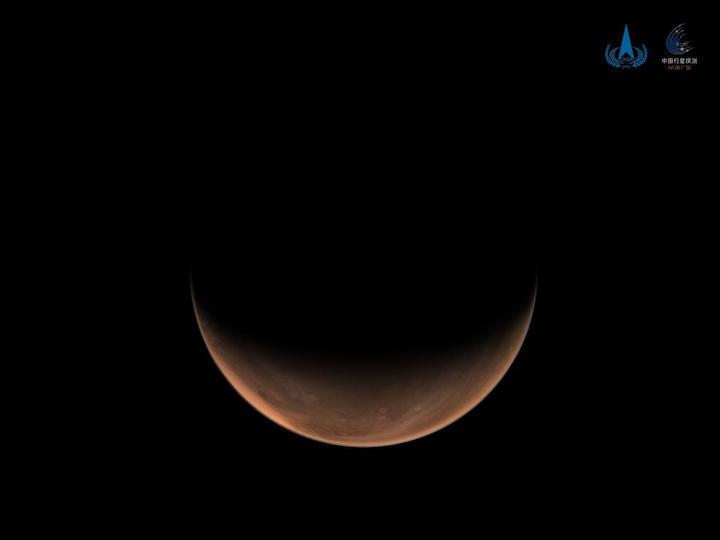
Photo taken on March 16, 2021 shows an image of Mars captured by China's Tianwen-1 probe. The China National Space Administration (CNSA) on Friday released two new images of Mars captured by the country's Tianwen-1 probe. In the images, Mars is crescent-shaped with a clear surface texture. When the Tianwen-1 probe was 11,000 km away from Mars on the far side of the planet to the sun, it took panoramic photos of Mars with a medium-resolution camera onboard. (CNSA/Handout via Xinhua)
Quelle: Xinhua
----
Update: 31.03.2021
.
NASA exchanged data with China on Mars orbiters
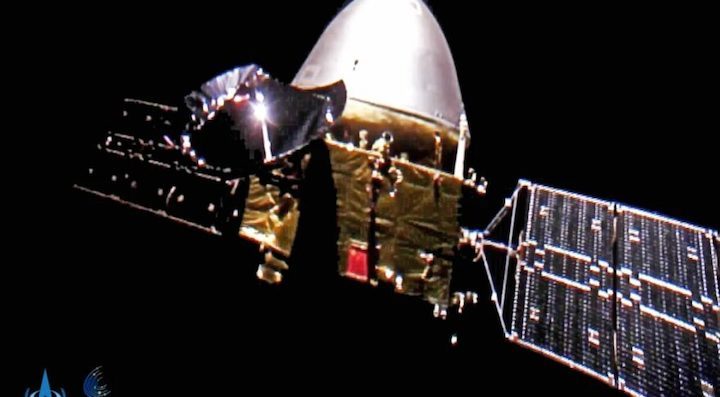
WASHINGTON — NASA sought congressional approval to talk with Chinese counterparts and obtain information on the orbit of China’s new Mars spacecraft, a move intended to lower the risk of a collision with other Mars orbiters.
NASA Acting Administrator Steve Jurczyk revealed the rare, but not unprecedented, discussions with China during a question-and-answer session after a March 23 speech at a meeting of the Federal Aviation Administration’s Commercial Space Transportation Advisory Committee, when a committee member asked him about what insight the agency had about Chinese space activities.
Jurczyk noted that NASA’s knowledge of China’s space program is largely limited to publicly available information because of restrictions placed by federal law on its interactions with Chinese organizations. Those restrictions do allow NASA to engage with China if approved by Congress.
“Most recently, we had an exchange with them on them providing their orbital data, their ephemeris data, for their Tianwen-1 Mars orbiting mission, so we could do conjunction analysis around Mars with the orbiters,” he said.
In a brief statement to SpaceNews late March 29, NASA confirmed it exchanged information with the China National Space Administration (CNSA), as well as other space agencies that operate spacecraft at Mars.
“To assure the safety of our respective missions, NASA is coordinating with the UAE, European Space Agency, Indian Space Research Organisation and the China National Space Administration, all of which have spacecraft in orbit around Mars, to exchange information on our respective Mars missions to ensure the safety of our respective spacecraft,” the agency said. “This limited exchange of information is consistent with customary good practices used to ensure effective communication among satellite operators and spacecraft safety in orbit.”
The statement, provided by NASA six days after SpaceNews first contacted the agency about Jurczyk’s comments, did not answer specific questions about the nature of the interaction between NASA and CNSA. Those questions included the level of risk the lack of accurate orbital data for Tianwen-1 posed to other Mars missions, and whether NASA was providing any warnings to CNSA of potential close approaches by Tianwen-1 to other spacecraft orbiting Mars.
NASA’s Jet Propulsion Laboratory operates a program called Multimission Automated Deepspace Conjunction Assessment Process (MADCAP) to perform conjunction assessments of spacecraft orbiting Mars. The program, originally called Mars Deepspace Collision Avoidance Process, also handles conjunction assessment for spacecraft orbiting the moon.
The handful of spacecraft currently orbiting Mars would appear to make odds of a collision between two of them remote. However, as JPL noted in a 2015 presentation about MADCAP, such spacecraft often operate in similar orbits, increasing the chances of close approaches. “The small number of assets makes the costs of collisions extremely high with respect to lost science capability,” it added.
MADCAP already incorporated orbital data from NASA’s Mars orbiters, as well as ESA’s Mars Express and ExoMars Trace Gas Orbiter spacecraft and ISRO’s Mars Orbiter Mission. However, in February, two new spacecraft entered orbit around Mars: the United Arab Emirates’ Hope and China’s Tianwen-1.
While the UAE was already cooperating with NASA on Hope, there was no cooperation with CNSA on Tianwen-1. China released little information publicly about the orbit of the spacecraft, which those familiar with the Mars program at JPL said had become a source of frustration because it made it difficult for them to predict any close approaches with other spacecraft. That was exacerbated by maneuvers Tianwen-1 made in the weeks after its Feb. 10 arrival to move into a “parking orbit” for the next few months.
Any exchange of information between NASA and CNSA or other Chinese organizations is restricted by what’s commonly known as the “Wolf Amendment” after former congressman Frank Wolf, who a decade ago chaired the House appropriations subcommittee that funds NASA and first included the restrictions. Similar provisions have been added to annual appropriations bills since then, including the fiscal year 2021 spending bill enacted in December.
Contrary to widespread industry belief, the Wolf Amendment does not categorically prohibit exchanges between NASA and Chinese organizations. The current version of the bill requires NASA — as well as the Office of Science and Technology Policy and the National Space Council — to certify with the Federal Bureau of Investigation that any proposed contacts with China pose no technology transfer or other national security concerns, and that those discussions will not include anyone the United States has determined to have been involved in human rights violations. NASA must notify Congress at least 30 days in advance of any proposed discussions with China.
While the Wolf Amendment is not an absolute prohibition on bilateral cooperation, it does have the effect of sharply reducing any collaboration. Jurczyk noted in his talk that NASA has previously won approval for discussions with Chinese organizations on topics like air traffic management and Earth science data. “We do have targeted engagement with them. We have the ability to certify to Congress that the engagement is appropriate and we have the safeguards in place,” he said.
It’s unclear if the exchange of information on orbital data will extend to data on operations of other phases of the mission, such as the deployment of a lander by Tianwen-1 as soon as May. Scientists working on NASA’s InSight Mars lander hope to record the acoustic and seismic signals created by the lander as it enters the Martian atmosphere and lands, but doing so requires more information about the spacecraft and the timing of its landing. Scientists said in February that the Wolf Amendment made obtaining that information difficult.
There have been efforts by some in the space community for years to allow greater cooperation between NASA and China, but that has not yet led to major changes in the Wolf Amendment. “It’s going to be up to the administration and Congress to determine if and how we engage with China on civil space activities as part of a broader strategy for the nation with China,” Jurczyk said.
Quelle: SN
----
Update: 3.04.2021
.
China’s Tianwen 1 mission targets mid-May landing on Mars
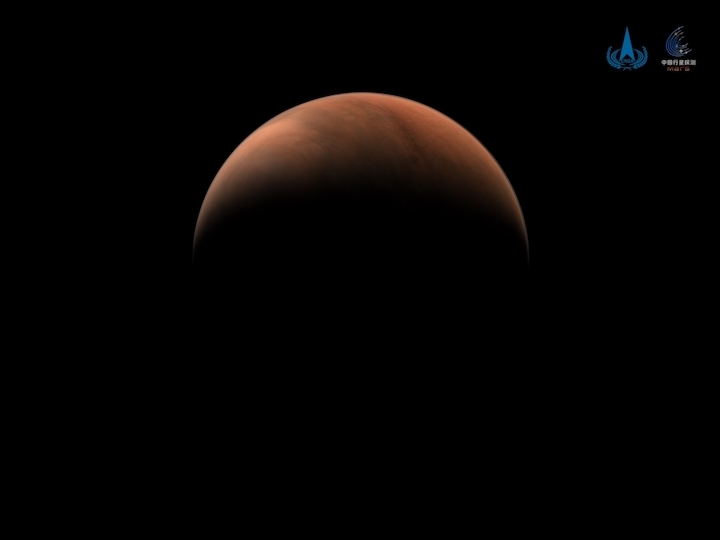
China’s Tianwen 1 spacecraft — in orbit around Mars since February — is scheduled to deploy a descent module to attempt the country’s first landing on the Red Planet in mid-May. Officials plan to share the Mars rover’s scientific data with researchers around the world, a senior Chinese scientist said last week.
Chinese officials have not announced the exact date for the attempted Mars landing. Tianwen 1 mission managers have more flexibility in setting the landing date than officials on other Mars missions.
Tianwen 1 will release its lander and rover from its position in orbit around Mars. Most Mars landers, such as NASA’s Perseverance rover, enter the Martian atmosphere on a direct course from Earth. Those trajectories typically have preset landing dates tied to when the missions launched.
Wang Chi, director of the National Space Science Center at the Chinese Academy of Sciences, said March 23 that Tianwen 1’s lander and rover are scheduled to touch down on Mars in May.
“The first Chinese Mars mission, Tianwen 1, is now orbiting Mars, and we are landing in the middle of May,” Wang said in a presentation to the National Academies’ Space Studies Board. “We are open to international cooperation, and the data will be available publicly soon.”
The Tianwen 1 spacecraft entered orbit around Mars on Feb. 10, completing a nearly seven-month interplanetary journey that began last July with a launch on a heavy-lift Long March 5 rocket, the most powerful launcher in China’s inventory.
The arrival of the Tianwen 1 spacecraft at Mars made China the sixth country or space agency have a probe orbiting the Red Planet, following the United States, the former Soviet Union, the European Space Agency, India, and the United Arab Emirates.
Since Feb. 10, the Tianwen 1 spacecraft has maneuvered into an orbit closer to Mars. The orbiter’s current path takes it as close as 174 miles (280 kilometers) and as far as 36,660 miles (59,000 kilometers) from Mars. Tianwen 1 completes one lap around the Red Planet every two days or so.
Tianwen 1 arrived at Mars one day after the UAE’s Hope orbiter steered into orbit around the Red Planet, and eight days before landing of NASA’s Perseverance rover. The favorable planetary alignment of Earth and Mars that allowed the three missions to reach Mars in February comes once every 26 months.

Tianwen 1’s lander and rover will target landing in a broad plain in the northern hemisphere of Mars called Utopia Planitia.
If China pulls off that feat, it will make China the third country to perform a soft landing on Mars — after the Soviet Union and the United States — and the second country to drive a robotic rover on the Red Planet.
The Tianwen 1 orbiter, which will continue its mission after releasing the lander and rover, is designed to operate for at least one Martian year, or about two years on Earth. The solar-powered rover, fitted with six wheels for mobility, has a life expectancy of at least 90 days, Chinese officials said.
Once it releases the lander and rover, the Tianwen 1 orbiter will adjust its orbit to transition into regular science operations. The orbiter will also relay communications signals between ground controllers in China and the rover exploring the Martian surface.
The Tianwen 1 rover is cocooned inside a heat shield for a fiery descent to the surface of Mars. After releasing from the orbiter mothership, the lander will enter the Red Planet’s atmosphere, deploy a parachute, then fire a braking rocket to slow down for landing.
Assuming the landing is successful, the rover will activate cameras, a subsurface radar, sensors to measure the composition of Martian rocks, a magnetic field monitor, and a weather station to begin collecting data at the Utopia Planitia location.
With the recent arrivals of China’s Tianwen 1 and the UAE’s Hope missions, there are now eight orbiters operating at Mars.
NASA’s Odyssey spacecraft, the Mars Reconnaissance Orbiter, and the MAVEN atmospheric observatory are currently returning data from Mars orbit, along with the European Space Agency’s Mars Express and ExoMars Trace Gas Orbiter, and India’s Mars Orbiter Mission.
NASA said last week had a “limited exchange” of information with China’s space agency since Tianwen 1’s arrival at the Red Planet to share data on the orbits of the Mars orbiters. The data-sharing initiative is aimed at reducing the risk of collisions between spacecraft operating at Mars, NASA said.
A provision in law known as the Wolf Amendment prohibits most bilateral cooperation between the U.S. and Chinese space programs. The Wolf Amendment is named after former Rep. Frank Wolf, R-Virginia, who first inserted the language into a NASA budget bill in 2011.
But the law does not restrict all contact between NASA and China’s space agency, provided the proposed collaboration passes a review by the FBI, and NASA informs Congress of the exchange at least 30 days ahead of time.
The China National Space Administration confirmed in a statement Wednesday that it held “working level meetings” with NASA from January through March on “exchanging ephemeris data to ensure the flight safety of Mars spacecraft.”
While NASA’s collaboration with China’s space program is limited, other nations have been more involved in Chinese missions like Tianwen 1.
Scientists from the Institut de Recherche en Astrophysique et Planétologie, or IRAP, in France contributed to a Laser-Induced Breakdown Spectroscopy instrument on the Tianwen 1 rover.
French scientists, with support from the French space agency CNES, provided guidance to their Chinese counterparts on the spectroscopy technique, which uses a laser to zap a pinhead-size portion of a rock, and a spectrometer to analyze the light given off by plasma generated by the laser’s interaction with the rock’s surface.
The technique allows an instrument to determine the chemical make-up of rocks on Mars. French scientists also provided China with a calibration target for the rover’s laser spectroscopy instrument.
The same French team worked on instruments on NASA’s Curiosity and Perseverance Mars rovers. The scientists hope to cross-calibrate measurements between the two U.S.-led missions and China’s Tianwen 1 rover.
Scientists from the Space Research Institute at the Austrian Academy of Sciences assisted in the development of the magnetometer on the Tianwen 1 orbiter and helped calibrate the flight instrument.
Argentina is home to a Chinese-owned deep space tracking antenna used to communicate with Tianwen 1. The European Space Agency also agreed to provide communications time for Tianwen 1 through its own worldwide network of deep space tracking stations.
Quelle: SN
----
Update: 20.04.2021
.
China to announce name of its first Mars rover
China will announce the name of its first Mars rover on the Space Day of China, which falls on April 24, according to the China National Space Administration (CNSA).
Nanjing, capital city of east China's Jiangsu Province, will host the main events marking this year's Space Day of China, Lyu Bo, a CNSA official, told a press conference on Monday.
The events include the opening ceremony, bilateral talks on the international lunar research station, and the fourth China Space Conference.
The name of China's first Mars rover will be announced at the opening ceremony on Saturday, Lyu said.
China launched Tianwen-1 on July 23, 2020. The spacecraft, consisting of an orbiter, a lander and a rover, entered the parking orbit of Mars after performing an orbital maneuver on Feb. 24.
The global campaign of naming the rover kicked off last July. Netizens at home and abroad were invited to vote for their favorite among 10 candidates from Jan. 20 to Feb. 28.
Last month, three possible names emerged, with "Zhurong," a fire god in ancient Chinese mythology, topping the list. Enditem
Quelle: Xinhua
----
Update: 25.04.2021
.
China names Mars rover for traditional fire god
China's space agency says its first Mars rover will be named Zhurong after a traditional fire god
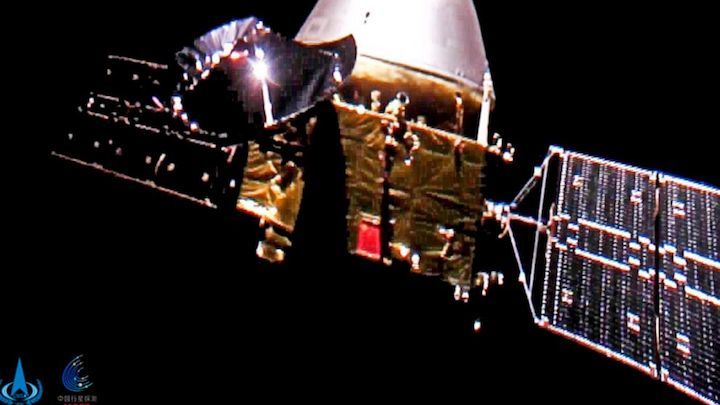
BEIJING -- China’s first Mars rover will be named Zhurong after a traditional fire god, the government announced Saturday.
The rover is aboard the Tianwen-1 probe that arrived in Mars orbit on Feb. 24 and is due to land in May to look for evidence of life.
It is part of Chinese space plans that include launching a crewed orbital station and landing a human on the moon. China in 2019 became the first country to land a space probe on the little-explored far side of the moon and in December returned lunar rocks to Earth for the first time since the 1970s.
The rover’s title fits with the Chinese name for Mars — “Huo Xing,” or fire star, the China National Space Administration said.
The name “signifies igniting the flame of China’s planetary exploration,” a deputy CNSA administrator, Wu Yanhua, was cited by the official Xinhua News Agency as saying.
The top candidate for the landing site is Utopia Planitia, a rock-strewn plain where the U.S. lander Viking 2 touched down in 1976.
CNSA says Tianwen-1's goals including analyzing and mapping the Martian surface and geology, looking for water ice and studying the climate and surface environment.
China would become the third country after the former Soviet Union and the United States to put a robot rover on Mars.
Quelle: abcNews
+++
China Focus: China's first Mars rover named Zhurong
China's first Mars rover has been named Zhurong, announced the China National Space Administration (CNSA) on Saturday, China's Space Day.
Zhurong is the god of fire in ancient Chinese mythology, which echoes with the Chinese name of the red planet, Huoxing (meaning the planet of fire).
Fire brought warmth and brightness to the ancestors of humankind, and fire lit up human civilization. Naming China's first Mars rover after the god of fire signifies igniting the flame of China's planetary exploration, according to Wu Yanhua, deputy director of the CNSA.
Literally, Zhu (meaning wish) expresses the good wishes for humankind's exploration of the universe. Rong (meaning integration and cooperation) reflects China's vision of the peaceful use of space and the building of a community with a shared future for humanity, Wu said.
The name is another example of Chinese aerospace workers' scientific romance as they have named spacecraft, including Tianwen, Chang'e and Beidou, after Chinese traditional culture, which also shows the Chinese people's spirit of exploration and cultural confidence, he said.
China launched its Mars probe, Tianwen-1, on July 23, 2020. The spacecraft, consisting of an orbiter, a lander and a rover, entered the parking orbit of Mars on Feb. 24.
The most challenging part of the mission will be the soft landing in May, an autonomous process of the probe lasting seven to eight minutes. The probe will use its aerodynamic shape, parachute and retrorocket to decelerate and buffer legs to touch down, according to the CNSA.
Chinese space engineers and scientists have chosen a relatively flat region in the southern part of the Utopia Planitia, a large plain, as the potential landing zone.
Earlier research showed the potential landing site might be the edge of an ancient ocean or lake in the early history of Mars. Chinese scientists are looking forward to finding more evidence of water-ice.
The scientific goals of Tianwen-1 include mapping the morphology and geological structure, investigating surface soil characteristics and water-ice distribution, analyzing the surface material composition, measuring the ionosphere and the characteristics of the Martian climate and environment at the surface and perceiving the physical fields and internal structure of Mars.
The orbiter is equipped with seven kinds of scientific instruments: two remote-sensing cameras, Mars-Orbiting Subsurface Exploration Radar, Mars Mineralogy Spectrometer, Mars Magnetometer, Mars Ion and Neutral Particle Analyzer and Mars Energetic Particle Analyzer.
The six-wheel solar-powered rover, looking like a blue butterfly with a mass of 240 kg, carries the Terrain Camera, Multispectral Camera, Mars-Rover Subsurface Exploration Radar, Mars Surface Composition Detector, Mars Magnetic Field Detector and Mars Meteorology Monitor.
The global campaign of naming the rover kicked off last July. Netizens at home and abroad were invited to vote for their favorite among 10 candidates from Jan. 20 to Feb. 28.
Last month, three possible names emerged, with Zhurong topping the list.
In 2016, China set April 24 as the country's Space Day to mark the launch of its first satellite "Dongfanghong-1" into space on April 24, 1970.
Nanjing, the capital city of east China's Jiangsu Province, hosted the main events marking this year's Space Day in China.
The various activities on Space Day have become a window for the Chinese public and the world to better understand China's aerospace progress. Enditem
Quelle: Xinhua
----
Update: 14.05.2021
.

Landing tomorrow! Zhurong (Tianwen-1) rover will attempt to land on Mars at UTC May 14 11:00PM. Save the time and check the latest information. Wish me good luck and will keep you updated. Here is the landing animation for your reference. (from: http://youtu.be/viGy-KnG0mU)
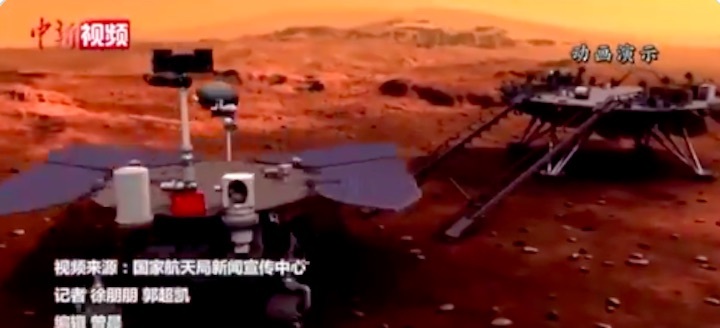
Quelle: YouTube
+++

